Monday 30 September 2013
Pampas deer - The World's Most Polymorphic Mammal
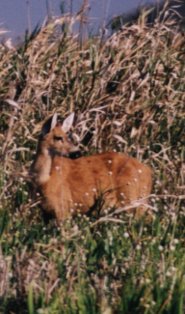
The
Pampas deer (
Ozotoceros bezoarticus) is known as the world's most polymorphic mammal. Their hide consists of tan fur that is lighter on the insides of their legs and their undersides. They have white patches under their throats and on their lips, and their coats do not change with the seasons.They have bushy, short tails and much like a white-tailed deer their tail is lifted when they run, thus revealing a white patch.
There are three subspecies of Pampas deer.
1.
O.b. bezoarticus - dwell in central and eastern Brazil, south of the Amazon and into Uruguay, and is pale red-brown in color.
2.
O.b. leucogaster - live in the southwest region of Brazil to the southeast section of Bolivia, Paraguay, and Northern Argentina and are a tawny-brown color.
3.
O.b. celer - live in the southern section of Argentina and are a bay color. This is an endangered species and the most rare Pampas deer.
Females are lighter, normally weighing around 33.5 kg or approximately 74 pounds, while males weigh in at an average of 40 kg or 88 pounds. Pampas deer usually have a body length of 110-140 cm, or 43 to 55 inches, and have a shoulder height of about 70-75 cm, or about 27 to 29 inches. Males have antlers while the females have whorls that look like mini-antlers stubs. The males antlers upper prong is divided, but the front main prong is just one solid piece. Males also have a special gland in their back hooves that secretes a smell that can be detected up to 1.5 km or almost one mile.
The Pampas deer is currently classified as a "near threatened" species, meaning they could have the potential of becoming endangered in the future, but as of now there are enough of them that they do not qualify as a threatened species.
Their diet usually consists of herbs, shrubs, and new green growth. They don't consume as much grass as they do browse, which are twigs, leaves, and shoots, and forbs, which are flowering big-leafed plants that have soft stems. They will usually migrate to the where the source of food is the greatest. While the Pampas deers living in Argentina and Uruguay no longer have to worry about predators, those living in Brazil must still be wary of
cougars.
Picture of the pampas deer by Carla Antonini, licensed under
GFDL
You can help spreading the word about this animal by liking it on facebook
Permanent Link
Wednesday 25 September 2013
Animal with the name "Fisher" not a fish-eater

The
fisher (
Martes pennanti) is a marten, living in North America. Despite its name, it seldom eats fish. Its name is believed to be derived from the French "fichet", which is the name for a pelt of the European polecat. They are solitary hunters. Interesting is that they are the only known predator to constently hunt porcupines and were reintroduced in some parts of North America to control the population of porcupines in the area. As a result, cats and dogs were also killed in the area by Fishers. They have a remarkable call, that sounds like a child screaming.
You can help spreading the word about this animal by liking it on facebook
Permanent Link
Tuesday 24 September 2013
The Beautiful Fork-Marked Lemur of Madagascar

The
Fork-marked lemur (
Phaner furcifer) is a primate found in Madagascar. They tend to live in two main parts of the country, including the humid forests of the eastern portion of the country as well as the dry and temperate forests in the western part of Madagascar. They spend a majority of their time in gum-producing trees, where they live and eat. The fork-marked lemur is known for their harvesting skills of gum trees in this region. They also possess a dental comb, which is a row of teeth on the lower jaw that allows for gum to be extracted from the trees. The fork-marked lemurs also eat some insects, although to a lesser degree than they consume gum.
As a rule, the fork-marked lemur lives in a monogamous relationship with their mate. Once bonded, the lemurs live together in a hole in a tree and share their lives there. They reproduce only with one mate at a time. Both males and females participate in the raising of offspring, although the females tend to play a larger role in the lives of young ones than males do. This is a similar trait found in many primates, including other lemurs.
Many are dying because of deforestation in their homelands. Lemurs are tree-dwelling creatures, and forestry has become a popular industry that is taking the lives of these animals. For this reason, the fork-marked lemur is rapidly becoming more and more endangered each year. Among potential predators are carnivorous tenrecs,
fossas, and herpestids native to Madagascar. These lemurs are also likely to fall victim to snakes and birds of prey.
The average life expectancy for the fork-marked lemur is around twelve years. One infant is born to a lemur pair each season, and infants are expected to live with their parents until able to fend for themselves. Actual life span has decreased greatly since many lemurs have no trees to live in while in the wild, but lemurs who are under the care of humans tend to live around twelve years.
These lemurs are most commonly known for their distinct markings on the face. The fork-marked lemur is named for its two black stripes that run from the eyes to the tip of the snout, making the animal stand out among its other lemur counterparts. These lemurs also possess large, bushy tails that can be between 29 and 37 centimeters long.
You can help spreading the word about this animal by liking it on facebook
Permanent Link
Monday 23 September 2013
The Kouprey - the World's Rarest Mammal
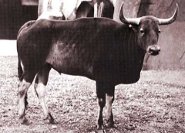
The
Kouprey (
Bos Sauveli), is a wild ox-like creature that primarily lives in the peripherals of dense, Cambodian monsoon forests, and it was first discovered by the western world in 1937 when one of the species was shipped to the Zoological Garden of Paris. The animal has long been a cultural icon to the people of South-East Asia, and the animal's importance to eastern society was exemplified when, due to its rarity, elusiveness, and mysterious behavior, Prince Sihanouk of Cambodia named the Kouprey the national animal of the country; the animal's importance to all humanity, however, lies in its possible facilitation of the study of genetics. The Kouprey's resilience to disease and its ability to survive in harsh climates may contain information helpful to scientists.
Weighing between 680 and 910 kilograms, the Kouprey is an herbivore that feeds on herbaceous vegetation as well as the shoots and leaves from trees and shrubbery; the Kouprey inhabits deep forests that border extensive grassy plains, and it grazes in the grassland at night while retreating into the safety of the forest during the day. The most unique physical feature of the animal is its frayed horns; due to its constant habitual digging, the oxen's horns fray and peel back around the age of three, but they continue to grow following this natural mutilation.
Though this mammal once lived in parts of Laos, China, Vietnam, Cambodia, and Thailand, its natural habitat and population have been significantly reduced due to illegal civilian and military hunting, illegal logging, disease, and slash-and-burn agricultural techniques; the Kouprey's habitat is now confined to Northern and Eastern Cambodia. With the date of the most recent confirmable sighting of the animal debatable, the Kouprey has been labeled critically endangered by the International Union for Conservation of Nature, or the IUCN. The only evidences of the animals continued survival are various sets of tracks that match those of the creature and sporadic instances of Kouprey skulls in Cambodian marketplace. Current estimates by the IUCN place the total population between 150 and 300, and it is widely pontificated that the animal will become extinct in the near future without bureaucratic protection and increased Cambodian awareness of the creatures tentative condition.
Picture of the kouprey by
Liger, licensed under
Creative Commons Attribution ShareAlike 3.0
You can help spreading the word about this animal by liking it on facebook
Permanent Link
Wednesday 18 September 2013
The Tibetan Fox - Silent Stalker of the Steppes
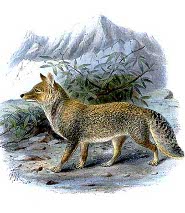
The Tibetan Fox (
Vulpes ferrilata), also known as the Wa or Wamo, is a smaller breed of fox that lives in the high altitude grassland plains of the Tibetan Plateau, China and India. They can also be found in the treeless slopes of Nepal, north of the Himalayas. They are characterized by soft, thick red fur with a grey undercoat and a white underbelly with a long, bushy tail that has a white tip. Their dense coat protects them from the fierce winds of the barren landscape. An adult Tibetan fox can grow as large as 2 feet in length (60 to 70 cm) and usually weighs 9 to 12 pounds (4 to 5.5 kg).
Discovered by Brian Houghton Hodgson in 1842, the Tibetan fox is best known for his uniquely square-shaped face and small, triangular ears that are set close to his head. Perhaps the square-shape is to facilitate hunting skills. These foxes have a very keen sense of hearing, making them excellent hunters. This fox lives in a burrow or hollow and rests throughout the day. They are most active at dawn and dusk, hunting for whatever they can find. Mainly feeding on pikas (small, black-lipped, rodents resembling rabbits), the Tibetan Fox are rarely found where pikas are not present. They also hunt other small mammals, lizards, insects, birds, and scavenge on the remains of dead carrion.
The Tibetan fox mates for life and often hunts in pairs. They begin mating in Late February through the end of March, usually having two to four kits after a 50 to 60 day gestation period. The kits are born in a den or burrow that has been dug by both of their parents. The young kits stay with their parents for about 8 to 10 months and then go off on their own to search for a mate, though not far, as these foxes are not territorial.
Domestic dogs have been known to kill the Tibetan Fox and can be considered a dangerous adversary. Other predators of the Tibetan Fox are human hunters, who kill them for their fur to wear as hats. Although not considered to be threatened or endangered at this time, a more indirect threat to the fox is the government sponsored poisoning of pikas, the fox’s main food source. If this program continues, the endangered status of the Tibetan Fox will need to be reassessed.
See also
Jan Reurinks pictures of the Tibetan fox
You can help spreading the word about this animal by liking it on facebook
Permanent Link
Tuesday 17 September 2013
The Peruvian Desert Fox, South America's Little Zorro
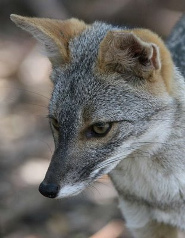
The
Peruvian Desert Fox (
Pseudalopex sechurae), is one of the “false” fox species more commonly known as zorros. Being a zorro means that the Peruvian Desert Fox is actually more closely related to dogs and wolves than to true foxes. The Peruvian Desert Fox is also known as the Sechuran Fox or the Sechuran Zorro.
The Peruvian Desert Fox has a somewhat limited range and can only be found on the coast of north-western Peru and south-western Ecuador. This animal frequently lives in agricultural, dry forests, and sandy deserts. Peruvian desert foxes are about eight-five centimeters, or two-point-eight feet, long including their tails. They usually weight between four and five kilograms, or about nine to eleven pounds. This animal is the smallest known species of zorro. Peruvian desert foxes are mostly grey with a lighter underbelly, although they sometimes have some reddish brown or tan patches of fur as well.
These animals are nocturnal and spend much of their days inside a burrow. They dig these burrows themselves using their curved claws. While sleeping, Peruvian desert foxes tend to wrap their tails around themselves to keep warm. These animals prefer a diet made up mostly of meat, although they will eat other items as well. Some of the foods typically eaten by them are
birds, insects, seed pods, berries, small mammals,
reptiles, and
amphibians. These animals are opportunistic and will even eat carrion. They will often use their claws to dig up food if necessary.
Very little is known about the socialization and reproductive cycles of Peruvian desert foxes, although it is known that the young are born in October. It has been difficult for scientists to keep track of their population trends as well, but it is thought that less than fifteen thousand adults are left in the wild. It is estimated that these animals will face a ten percent population decline in the next decade. These animals are currently listed as Near Threatened by the IUCN Red List of Threatened Species. There are a few factors that contribute to the decline of these zorros.
These animals have a limited range, so habitat loss can have a very negative impact on their population. Habitat loss and degradation are considered the biggest factors in the Peruvian Desert Fox’s decline. This animal is also often hunted for various uses. Parts of the animal are used as souvenirs while others are used in rituals by certain shamans in the area. Finally pups are taken to be sold in the pet trade. The final major threat to these mammals is that they are often killed by farmers because they are a threat to livestock.
The Peruvian Desert Fox is an intelligent and hard to find species. Hopefully more will be known about these animals in the near future. More information would also help conservation efforts to better understand and protect this animal.
Picture of the Peruvian desert fox by Mike weedon, licensed under
GFDL
You can help spreading the word about this animal by liking it on facebook
Permanent Link
Friday 13 September 2013
Siberian Chipmunks - Exceptionally Hygienic Omnivores

The
Siberian Chipmunk (
Tamias sibiricus) is the only member of its genus that lives outside America. Ranging from Russia to China, northern Japan, Korea, and northern Asia, its main habitats include woodlands with thick bushy vegetation.
Its total length from head to tail is 18 to 25 cm (3.93 to 9.84 inches) of which one third is occupied by its tail. The weight of an adult Siberian chipmunk varies according to the season but normally, an adult Siberian chipmunk weighs about 50 to 150 grams (1.76 to 5.29 oz). When compared to its other relatives such as the
red squirrel, it is rather smaller in size.
The Siberian chipmunks are omnivorous animals and feed on mushrooms, shrubs, small birds, berries, and small animals. Their diet includes conifer seeds, nuts, and vegetables and they also eat tree buds, wheat, buckwheat, and oats. Chipmunks also prey lizards and insects. Mustelids, cats, and birds are the main predators of the Siberian chipmunk. This species can prove dangerous since it can spread grave diseases like rabies by its bite. Siberian chipmunks have made colonies in some parts of central and Eastern Europe, since they escape easily from captivity.
In some parts of Europe, the Siberian chipmunk is being kept as a pet but it needs a very spacious place for climbing and the place should be covered properly to avoid retreat. They are not much active during winters but generally avoid sleeping for a long time in heated rooms. Their lifespan is short in the wild but in captivity, they can survive for more than 10 years. It is a universal fact that animals born in captivity become disciplined to some extent. The Siberian chipmunk generally enjoys feeding on vegetables, fruits, rodent lab-blocks and nuts.
Like its relatives, it has bright colored fur with dark stripes, and large pouches in its cheeks to collect food. Its ears are small and rounded up at the ends. The color of its fur depends on the origin of the animal. The fur is brown grey or tawny yellow. Along its flanks there are five dark and four light colored long stripes. The color of its tail is light brown and there are thick black lines on both sides with small white edges.
They mainly live in forests. Their needle-pointed claws make them a superb climber but most of the time, they stays on the ground. They construct lodges on the ground to live in and in order to store food, the Siberian chipmunks bury their food 5 to 7 cm under the ground. They are hygienic and clean themselves from head to tail. Sometimes, they even clean one another. They make various sounds including a bird-like 'cheep' short whistle which lasts only for 1 or 2 seconds. They make this sound 5 to 6 times constantly when they smell any danger. They are most active during the day time.
You can help spreading the word about this animal by liking it on facebook
Permanent Link
Monday 09 September 2013
Cuban Solenodon
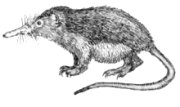
The shrewlike
Cuban Solenodon (
Solenodon cubanus) has short legs and it possesses skin glands that produce a goat-like smell. Its elongated head has tiny eyes coupled with a flexible snout. Their fur could be any of the following: black, red-brown or dark brown. They could be found in both forests and scrublands, and in the main, they are terrestrial. However, the Cuban Solenodons have the ability to climb. At the ground level, they move with an unsteady gait, but for short lengths, a Cuban Solenodon could run quickly.
At night when they are foraging for food, they use that snout to tear tree trunks. Their diet also consists of snakes, frogs, and crabs. A Cuban Solenodon is basically social, with many members residing in a single hole (burrow that is). A Cuban Solenodon communicates with others via squeaks, squeals and twitters. They comprise the family Solenodontidae, and this in turn belongs to a set of mammals termed as insectivores by the scientific community.
Wilhelm Peters discovered this breed of solenodons in 1861. By 1970, everybody thought they had gone extinct. Wrong, three individual solenodons were caught in the mid-70s. Still, they are rare in any part of the globe they exist in. Before 2003, the last sighting came in '99 and no wonder- they are night burrowers and they live in the basement, so to speak.
In 2003, one of them was captured and it raised the number of captured to 37 (they named it Alejandrito). It was released later on, after experts studied it for just a couple of days.
Interesting fact: The solenodon adults approach one another with their mouths open, probably giving out high-frequency sounds.
Another interesting fact: The solenodon is one of the species of mammals that has venomous saliva.
You can help spreading the word about this animal by liking it on facebook
Permanent Link
Friday 06 September 2013
Gemsbok (Oryx gazella)
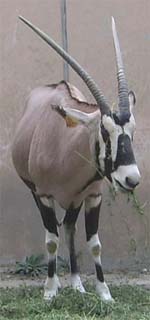
The gemsbok or
gemsbuck (
Oryx gazella) exists mostly in the southern part of East Africa and have been introduced in Mexico and the southwestern United States. Its name is actually derived from the German word for a male
chamois, although they are not related. The Gemsbocks are known for their capability to last a long time without water. They have a special mechanism to loose heat quickly: they raise their body temperature to 45 degrees Celsius. Oryx gazella is the largest of the Oryx family of antelopes and are hunted by lions,
cheetahs,
leopards,
spotted hyenas and
African hunting dogs. Their conservation status is 'Lower risk - conservation dependent'.
Image: user Shizhao, licensed under Creative Commons Attribution 1.0
You can help spreading the word about this animal by liking it on facebook
Permanent Link
Tuesday 03 September 2013
Black-backed jackal
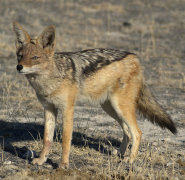
The
Black-backed jackal (
Canis mesomelas), also known as the Silver-backed jackal lives in two distinct regions in Africa. One region is South Africa, Namibia, Botswana and the other Kenya, Somalia, and Ethiopia. The Black-backed jackal lives in scrubland, open woodlands, savanna, and bush. They live in pairs most of their lives and are very territorial. Black-backed jackals can team up together when hunting for antelopes or impala.
A Black-backed jackal weighs on the average about 5 to 10 kgs. They have black hair, from which their name is derived, found from the nape all the way to its tail's area. Their chest and underparts are white. The rest of their fur can go from red-brown to ginger shade. Its head is very much like a dog's, possessing a pronounced muzzle and ears that are high-pointed. The female Black-backed jackal's color is usually less pronounced.
They are mainly nocturnal, but jackals can be active both in nighttime and daytime. If it is living near the borders of human settlement, it only comes out at night. When they go after a prey, its ears are pricked. Their senses of smell and hearing are very well-developed. This particular kind of jackal is cautious when it comes to human beings, and against bigger animals, they are not aggressive, unless threatened.
Their diet can consist, besides impala, fur seal cubs, gazelle, guinea fowl, of insects, reptiles, birds, grass, fruits, snakes and they could even go through trash dumps just to look for something. Black-backed jackals are not endangered, and one major reason is their resourcefulness.
Interesting fact: Because of their speed, the black-backed jackal can snatch a bite or two from under a lion's, hyena's, or leopard's nose.
Picture of the black-backed jackal by
Hans Hillewaert, licensed under
Attribution ShareAlike 2.5
You can help spreading the word about this animal by liking it on facebook
Permanent Link
Monday 02 September 2013
Maned three toed sloth

The
Maned three-toed Sloth (
Bradypus torquatus) is a sloth that comes from South America and is related to the other three-toed sloths of the South American variety. The Maned Sloth is about 50 centimeters in length (19 inches) and weighs about 4.5 kilograms (or 10 pounds). Unusual is its proportions of body parts, with very small eyes, small ears, and a tail that is hidden from view, along with a small head. Their fur is of interest as it has a fine undercoating of fur, but atop that is the outer coating which is a virtual ecosystem in its own right. The outer coating is usually infested and inhabited by moths, beetles, ticks, mites, algae and moss.
The Maned three-toed sloth belongs to the genus Bradypus, which has only four other species of three toed sloths and most are threatened or endangered. Bradypus belongs to the family of Bradypodidae, which has no other members but the genus Bradypus. Bradypodidae belongs to the suborder Folivora, which is the sloth in general, as it contains only one other family - Megalonychidae, or two-toed sloths. The full order than Folivora belongs to is called Pilosa, which also only has one other suborder - Vermilingua, otherwise known as anteaters.
The diet of the Maned three-toed sloth is that of an omnivore, eating buds off of trees or insects that happen to come its way. They spend the majority of their time in trees and seldom come down, unless they can not move to another tree from the tree they are on, or they need to get rid of waste. On the ground the sloth is almost helpless, as it can only crawl using its front limbs, and will drag the hind limbs behind it. Their primary defense is their fur, as it hides them from most predators, however failing that it is their sharp claws and strong arms - although the sloth is known for being very slow, it can react quickly when threatened. Additionally, they are excellent swimmers, and if they have the chance they will dive away from a potential threat and swim away - which is in stark contrast to their ability to move on land.
Gestation (pregnancy) lasts for five to six months, and then the young sloth will cling to its mother for the first four weeks of its life, gripping with its already highly developed claws. After the suckling is finished it will remain with its mother, usually riding on her back, for up to six months to learn the habits and feeding styles of the adult. Eventually it will venture out on its own, where it can live for up to twelve years in the wild - barring it being cut down with a tree or shot by poachers for its meat or as a trophy.
The Maned three-toed Sloth is an endangered species, and is close to being listed as Critically Endangered, mostly due to deforestation and destruction of its natural habitat. Due to the mass slash and burn policies to create land for farming or grazing cattle the Maned three-toed Sloth is now restricted to only a few habitats, one being in Brazil, and spread around the areas surrounding northern Brazil. To compound this problem, the sloth is generally hunted for meat or trophy sport, creating a spiral of de-population that could soon make the species extinct.
Some interesting facts about the Maned three-toed Sloth
- Due to its ‘upside down’ lifestyle the Maned three-toed Sloth has fur that is ‘backwards’ in that instead of being directed from the back down to the abdomen, it is directed from the abdomen to the back.
- Sloths are related to Anteaters, and also because they are in a super-order (Xenartha) they are related to armadillos, the extinct glyptodonts (super armadillos), the extinct pampatheres (giant armadillos) and several extinct sloth species (including the ground sloth that may have gone extinct in 1500 AD, and the giant sloths that grew taller than 17 feet).
You can help spreading the word about this animal by liking it on facebook
Permanent Link
 The Pampas deer (Ozotoceros bezoarticus) is known as the world's most polymorphic mammal. Their hide consists of tan fur that is lighter on the insides of their legs and their undersides. They have white patches under their throats and on their lips, and their coats do not change with the seasons.They have bushy, short tails and much like a white-tailed deer their tail is lifted when they run, thus revealing a white patch.
The Pampas deer (Ozotoceros bezoarticus) is known as the world's most polymorphic mammal. Their hide consists of tan fur that is lighter on the insides of their legs and their undersides. They have white patches under their throats and on their lips, and their coats do not change with the seasons.They have bushy, short tails and much like a white-tailed deer their tail is lifted when they run, thus revealing a white patch.
 The
The  The
The  The
The  The Tibetan Fox (Vulpes ferrilata), also known as the Wa or Wamo, is a smaller breed of fox that lives in the high altitude grassland plains of the Tibetan Plateau, China and India. They can also be found in the treeless slopes of Nepal, north of the Himalayas. They are characterized by soft, thick red fur with a grey undercoat and a white underbelly with a long, bushy tail that has a white tip. Their dense coat protects them from the fierce winds of the barren landscape. An adult Tibetan fox can grow as large as 2 feet in length (60 to 70 cm) and usually weighs 9 to 12 pounds (4 to 5.5 kg).
The Tibetan Fox (Vulpes ferrilata), also known as the Wa or Wamo, is a smaller breed of fox that lives in the high altitude grassland plains of the Tibetan Plateau, China and India. They can also be found in the treeless slopes of Nepal, north of the Himalayas. They are characterized by soft, thick red fur with a grey undercoat and a white underbelly with a long, bushy tail that has a white tip. Their dense coat protects them from the fierce winds of the barren landscape. An adult Tibetan fox can grow as large as 2 feet in length (60 to 70 cm) and usually weighs 9 to 12 pounds (4 to 5.5 kg). The
The  The
The  The shrewlike
The shrewlike  The gemsbok or
The gemsbok or  The
The  The
The